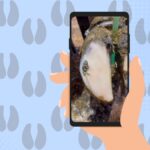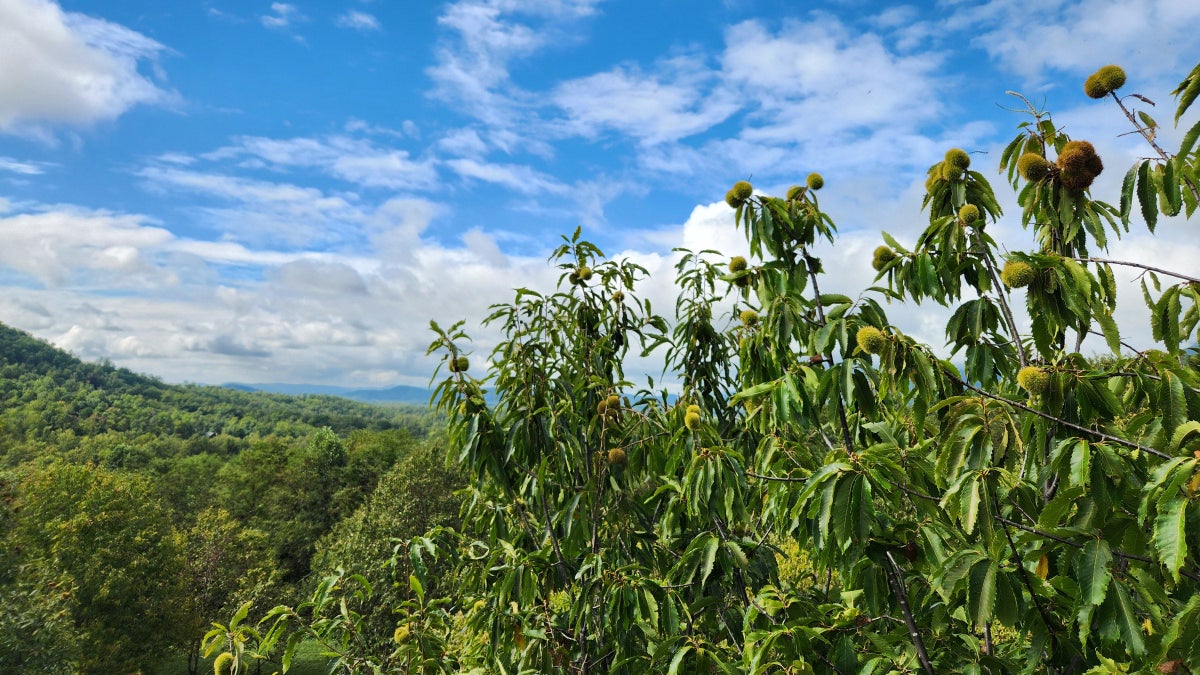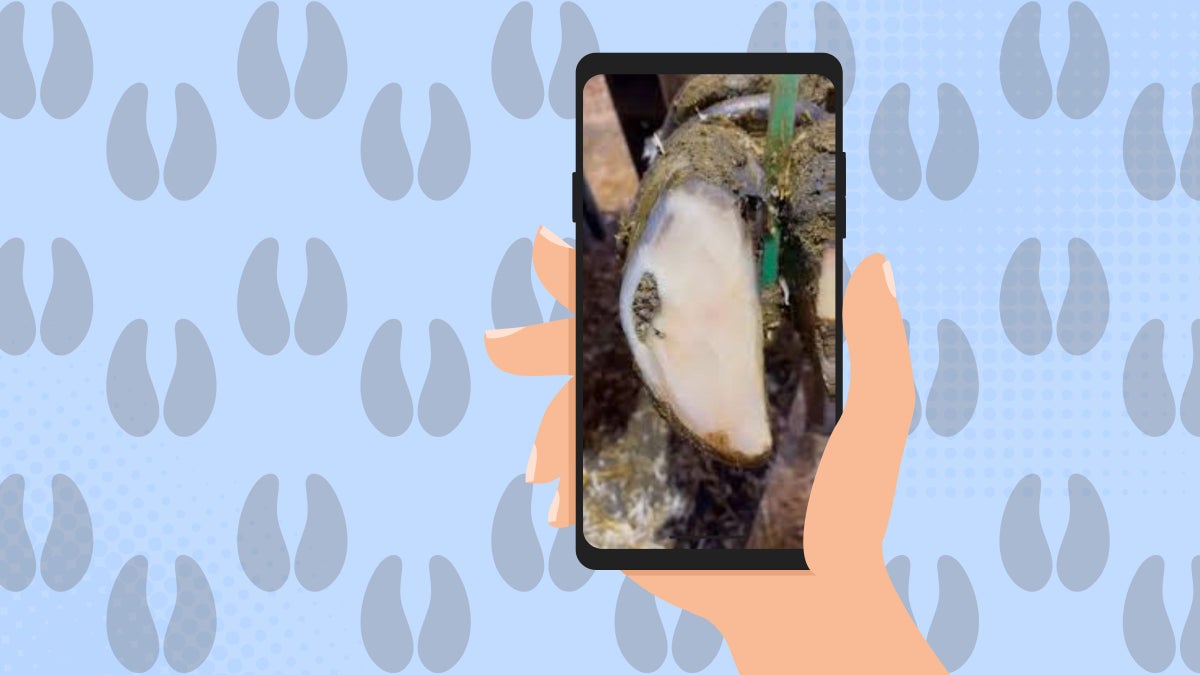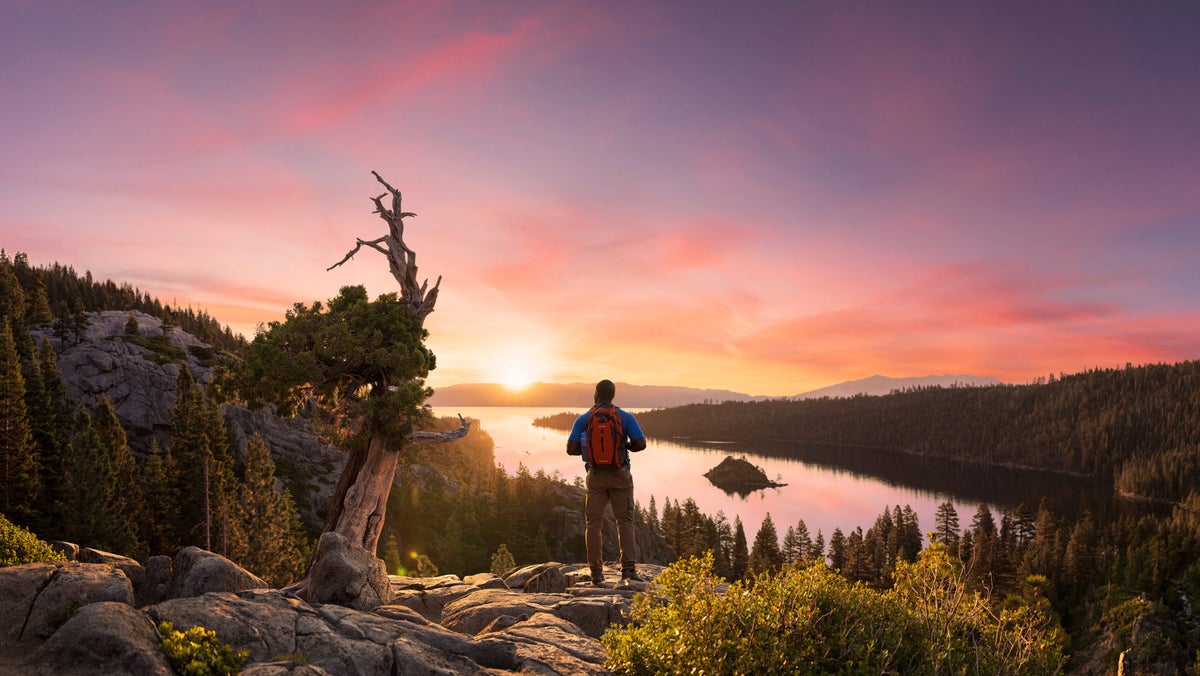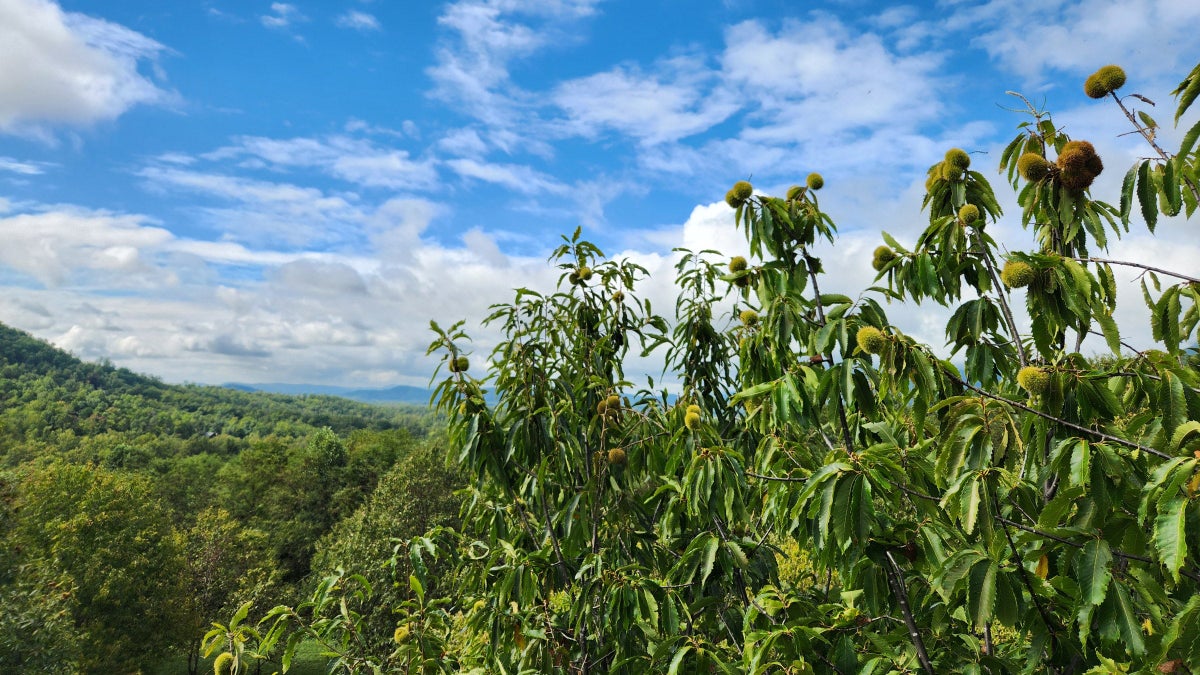
We park deep in the backwoods of Nelson County, Virginia, on the shoulder of a one-lane gravel road. My wife and I dip around a locked metal gate and follow the grassy service route up a steep hillside lined with towering tulip poplars and white oaks. There’s no one else in this corner of Lesesne State Forest. Only the sounds of our muffled footsteps, the chitter of songbirds, and the breathy cool of an early-autumn breeze in the treetops break the silence.
The road eventually crests the hill and, after a long flat stretch, we’re treated to half-mile views of lazy, cotton ball clouds drifting over 4,000-ish-foot peaks in the George Washington National Forest’s Three Ridges Wilderness Area. With a little bushwhacking, we could easily hop on the Appalachian Trail (AT) or the Blue Ridge Parkway.
Distracted by the eye candy, I slip on what feels like a squishy ball of turf and nearly roll an ankle. I start to curse, but my anger morphs to glee as I spot a pair of spiny, fist-sized chestnut burs buried in the shin-deep grass.
A quick scan of the 50-plus-foot canopy confirms that we’ve found what we’ve come for: A dappling of brownish, green-yellow burs cling to the high limbs of some of the rarest hardwoods on the planet. They signify a major step in a nearly century-old effort to overcome a pernicious blight that effectively drove what used to be one of America’s most important trees into extinction.
We crunch into the dense forest to find one- and two-foot-wide trunks surrounded by broad patches of understory scattered with the husks of old burs and this year’s ongoing masting. We spend the next hour or so scouring the ground, heeling open the urchinlike orbs and filling a small grocery bag with dark, leathery nuts. For me, the experience is moving—like a glimmer of wild hope amid a conservation landscape dominated by the looming catastrophes to come of climate change.
While the hiking in Lesesne State Forest is limited to gated roads like the one we’re on, it’s a worthy place for a stroll. In the 1970s, the Virginia Department of Forestry planted an orchard of American chestnut trees here, and it remains the largest and oldest experimental planting of the species in the U.S., according to Cassie Stark, regional science coordinator for the American Chestnut Foundation (TACF). In addition to the orchard, 422-acre Lesesne holds about 30 acres of natural, second-growth woods anchored by American chestnut trees. Some are upward of 60 years old and produce famously delicious wild nuts that few living people beyond foresters, researchers, and volunteers have ever tasted.
“It’s not something that we advertise,” says Stark, but backpackers can now explore groves of healthy, effectively wild American chestnut trees across numerous eastern states and forage for nuts for the first time in about a century. The effort behind them, says Stark, “is one of the most epic conservation stories ever told.”
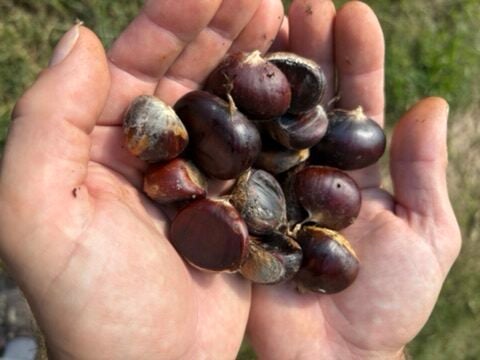
Apocalyptic Blight and The Death Of America’s Tree
The rewilded orchards at Lesesne might seem commonplace to an uninformed trekker. But if you know their backstory and telling characteristics, strolling through one of these groves feels like a real-life miracle.
“When the European colonists got here, American chestnut trees were a dominant species throughout most of the eastern piedmont and Appalachian Mountain range,’’ says veteran forester and TACF board member, John Scrivani, 72. Their trunks could grow to be 10 feet wide and stretch upward of 105 feet into the canopy; limbs spanned an equally wide footprint. The trees could live for three or more centuries and covered an estimated 300,000 square miles of land from Maine to Mississippi.
“This was the tree of early America,” writes author Susan Freinkel in her book, American Chestnut: The Life, Death, and Rebirth of a Perfect Tree. Carpenters prized their strong, straight-grained, and decay-resistant wood. Farmers praised their ability to feed and produce world-class livestock. Sportsmen revered them as a primary food source for wildlife. Gourmands celebrated their dry fruit as the world’s tastiest variety of chestnut.
“It’s impossible to understate the importance of American chestnuts for the developing U.S.,” Freinkel continues. It came to be known as “a perfect tree and had a value and versatility unmatched by any other hardwood.”
Then came a virulent, invasive fungus from East Asia called Cryphonectria parasitica. Better known as chestnut blight, it was accidentally introduced in New York by way of imported Japanese varieties in the late 19th century and spread like wildfire through eastern forests.
“The fungus enters a tree through a wound in the bark, spreads laterally around stems and limbs, destroying the vascular system and killing growth above the point of infection,” says Scrivani. “The tree eventually dies back to the ground and, while new sprouts often emerge, they rarely grow large enough to flower. Reproduction and natural evolution halt.”
By 1941, the blight had eradicated 3.5 billion American chestnut trees, rendering the species functionally extinct.
“This is one of the most extreme recorded changes in a natural plant population caused by an introduced organism in history,” says West Virginia University emeritus professor of plant pathology and former TACF president, William MacDonald. Had it been avoided, backpackers on the AT, for instance, would experience a drastically different landscape and be able to roast foraged nuts on their campfires throughout the fall.
Restoration and a Hail Mary Return
While most 1940s biologists forecasted permanent doom for the American chestnut, some clung to a wily optimism.
“There was tremendous nostalgia around these trees,” says retired West Virginia University professor of plant pathology, Mark Double, who’s studied American chestnuts with organizations like the TACF and the U.S. Department of Agriculture since the mid-1970s. He recounts the story of a pair of Greatest Generation brothers from Ohio, for instance, who remembered “gathering nuts from a huge tree in their yard to sell at a train station so they could afford new shoes for the winter.”
Similar stories abounded throughout the eastern mountain regions, so interest in restoring the iconic tree rose during the post-war 1950s. A loose cadre of agronomists, foresters, biologists, university researchers, and interested citizens began to take shape. Some studied the blight fungus and looked for clues to how it could be stopped. Others scoured forests for nuts and surviving trees, or gleaned clippings from sapling sprouts that they grafted onto Chinese rootstock for study.
A breakthrough came when an amateur botanist named Robert Dunstan used clippings to cross-breed an anomalous, surviving American chestnut tree from Ohio with a blight-immune Chinese cousin. The result was a hybrid that survived fungal inoculation and bore nuts around 1962. Dunstan presented his findings to fellow members of the Northern Nut Growers Association and his namesake chestnut went on to become a favorite of commercial U.S. orchardists.
The work also caught the attention of conservationists. It and advances like the 1975 discovery of an Italian hypovirus that attacked certain strains of blight helped inspire the formation of the American Chestnut Foundation in 1983. The organization would serve as a central force for disseminating information and furthering research aimed at restoring American chestnuts to the wild. The primary driver of that mission was an ambitious, multigenerational back-cross breeding program that would be to prior efforts what Apollo 11 was to the Wright Brothers.
“The idea was to back-cross the hybrids with wild stock, 100 percent American parents through seven generations and produce trees that were genetically identical to American chestnuts, but had enough blight resistance to survive in the wild,” says Scrivani, who’s spent about four decades spearheading related efforts and research at groundbreaking sites like the one at Lesesne State Forest. New generations were inoculated with the fungus at maturity, “then monitored so that we could pick the ones that showed the highest blight resistance for further breeding.”
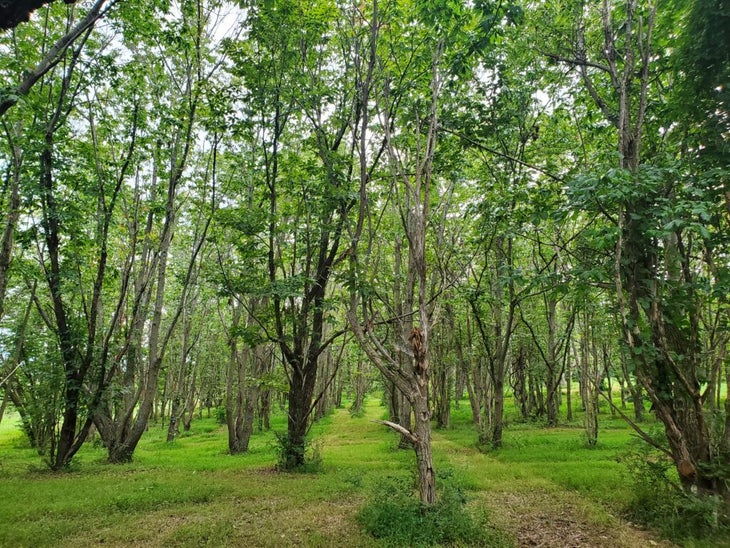
The work is painstakingly slow: Each generation takes three to five years to reach maturity, survive inoculation, and bear nuts. But dedication and dogged persistence have brought about 700 large-scale plantings across 2,000 acres of public and private land in the eastern U.S. to date. The majority are managed, monoculture research or nursery orchards aimed at producing increasingly blight-resistant trees through a variety of methods. Some—like a Maryland-based program that used high radiation in hopes of triggering favorable genetic mutations—failed spectacularly. Others, like the rewilded planting at Lesesne, sought to test newly honed resistance in the wild and see how trees competed with dominant native species like oak and hickory. Hikers can trek through dozens of the sites at any time. Visits to most others can be arranged by emailing the catch-all address for the individual TACF state chapters.
“What they’ve achieved at sites [like Lesesne] is really quite spectacular,” says Double. It took decades of breeding to produce trees with enough blight resistance to survive in a controlled forest setting—and even then, more than half died. Careful early management of competitors, though, enabled survivors to establish themselves in the canopy and eventually thrive without further intervention.
“These stands are now self-reproducing, and you can find occasional seedlings in the understory,” says Scrivani. When you walk through the forest, you’re experiencing a natural landscape that countless people have helped resuscitate from the brink of extinction.
Breakthroughs and Next Steps
Scrivani, Double, and Stark agree that the possibility of restoration en masse is still a century or more away. But they’re quick to add that it’s no longer a question of if, but of when and across how many acres of land.
On one hand, “the breeding program has made tremendous advancements over the past 40 years,” says Scrivani. “We’re now only working with trees that exceed minimum requirements for both disease resistance and a high proportion of American ancestry,” and the results improve with each generation.
The progeny of these select trees are now being used to anchor new plantings on public or public-adjacent lands from Alabama to Maine. Half of them will probably die, says Scrivani, but the others could go on to parent groves like the one at Lesesne. Slow, steady growth, coupled with additive peripheral plantings, would drive natural expansion.
Scrivani acknowledges that there have been setbacks—most notably a genetically modified, blight-resistant tree called Darling 58, created by researchers at the State University of New York College of Environmental Science and Forestry in 2012, which showed immense early promise before failing miserably in field plantings. But a slew of other promising advancements reinforce his optimism. Double has been studying the fungus-killing Italian virus for decades and believes it and similar variants can play a vital role in finally beating the blight.
“We’ve shown that we can safely inoculate trees with the virus and dramatically increase their chances of survival,” says Double. However, USDA regulations forbid the purposeful release of the virus into the wild. Furthermore, it only attacks certain strains of blight.
Double acknowledges the hurdles, but believes they’re manageable. Ongoing discussions with the USDA are making progress and a genetically modified form of the virus that can attack all varieties of chestnut blight is currently under development. It could eventually be applied to blight-inoculated trees in orchards that are then replanted into the wild.
Scrivani likes to envision a future around the year 2130 where hikers on beloved routes like the AT, Benton MacKaye, and the Long Trail pass through groves of monstrous American chestnut trees and the smell of roasting nuts mixes with campfire smoke in the autumn air. In the meantime, trekkers can visit locations like Lesesne for a taste of what’s to come.
“I’ve dedicated much of my career working with many others to the goal of making that a possibility for future generations and feel confident that it will happen,” says Scrivani. “It brings me joy to think that my great-great-great grandchildren could get to experience something like that.”
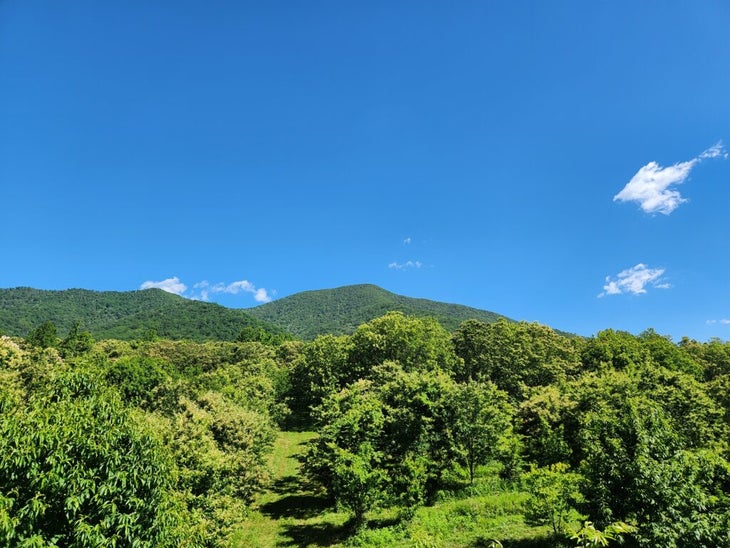
Take a Hike Amongst Chestnut Trees
Want to experience an American chestnut grove for yourself? Like Lesesne State Forest in Virginia, these walks carry you through a few of the nation’s best and most beautiful. Foraging is allowed, but it’s important to be sparing and practice good stewardship.
Sleeping Giant State Park, Hamden, Connecticut
Early chestnut crusader and Brooklyn Botanic Garden curator, Arthur Graves, began planting chestnuts on his family’s Hamden farm around 1930. He hoped to establish blight resistance in American trees through crossbreeding and compiled a collection that now includes every species of chestnut and its closely related chinkapin worldwide. Graves eventually donated his land to the park and neighboring Connecticut Agricultural Experiment Station. Visit the latter’s Lockwood Farm to see his incredible collection, then pursue the 5.1-mile Blue Trail through Sleeping Giant and an 8-plus-acre plot of rewilded American and hybrid chestnut trees upward of 75 feet tall.
Sugarloaf Mountain Park, Dickerson, Maryland
Explore a fascinating piece of history about 28 miles west of the AT crossing at Harpers Ferry at this 3,400-acre National Natural Landmark. About 15 miles of hiking trails loop around the park’s namesake 1,282-foot peak and pass through a number of experimental American chestnut orchards. The oldest dates back to 1970 and holds big, gnarly trees grown from 100 percent American irradiated nuts grafted onto Chinese rootstock.
Johns Creek Mountain, Pembroke, Virginia
Find a 4-acre grove of American chestnuts competing in a competitive forest environment in the George Washington and Thomas Jefferson National Forest near the famed Mountain Lake Lodge, where “Dirty Dancing” was filmed. Around 1,200 trees with what was then considered very high blight resistance were planted in a clear-cutting on the slopes of the 3,700-foot ridge. About half succumbed to the fungus, but the 14-year-old survivors are thriving and producing nuts. They’re located down a 2-mile-long, gated forest road, so contact the Virginia TACF chapter to arrange a visit.
The post Nearly a Century Ago, American Chestnut Trees Died Off. Now, Hikers Can Walk Among Them Again. appeared first on Outside Online.







